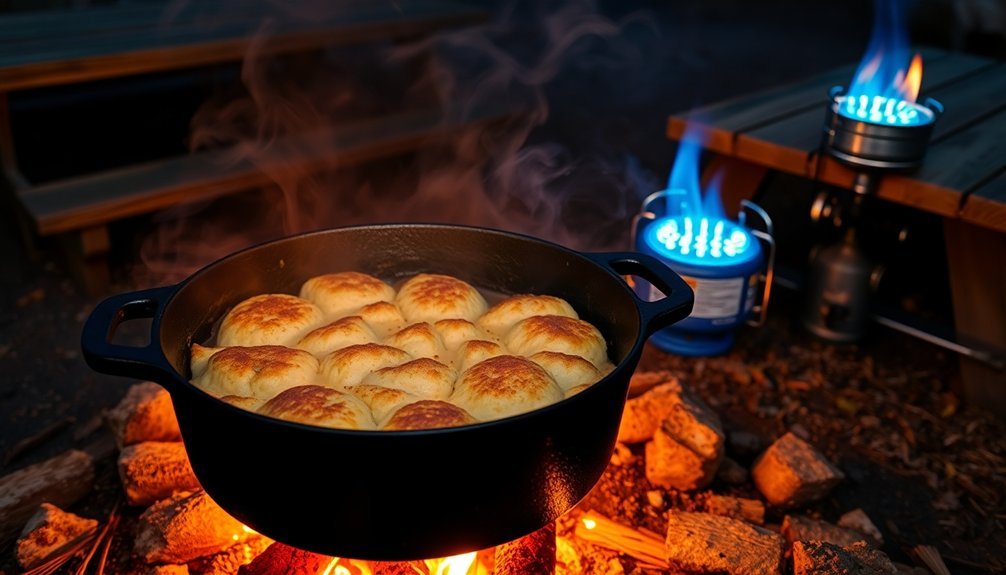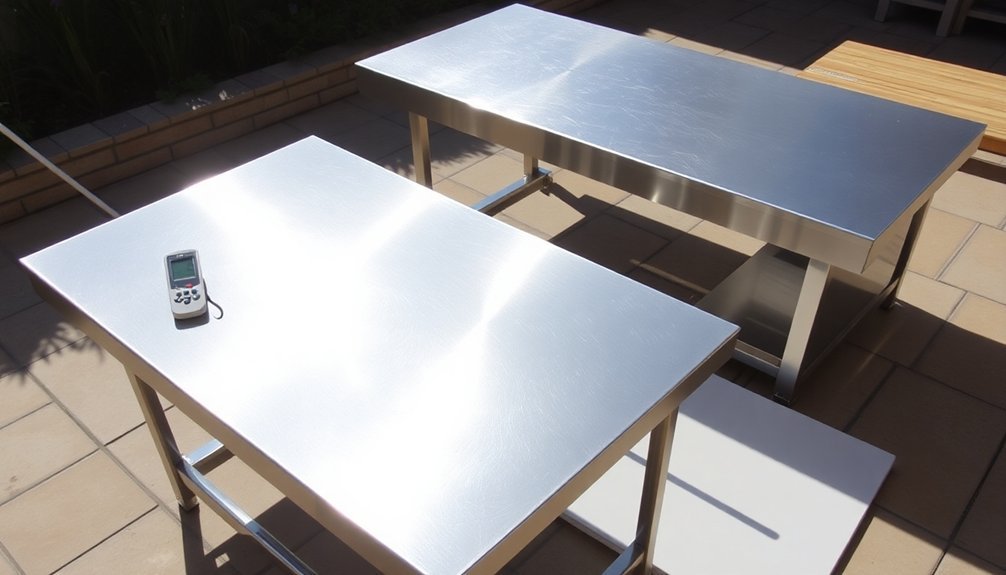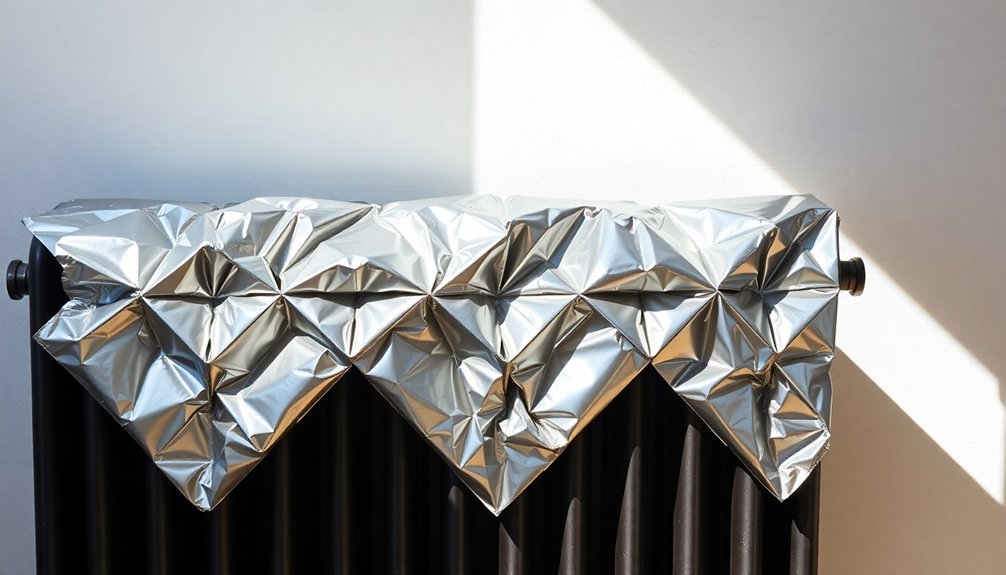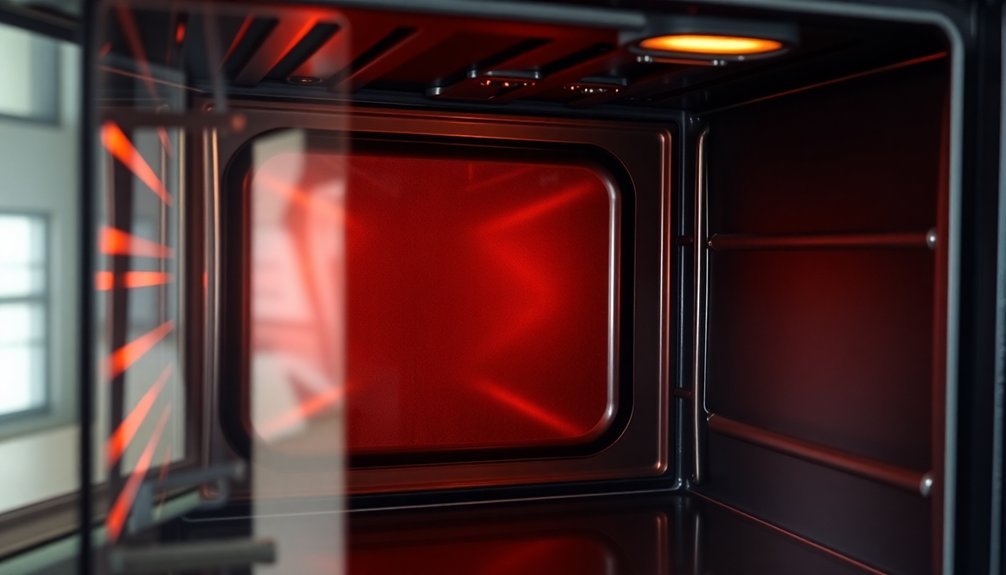You'll love these easy off-grid recipes that harness natural heat sources. Try solar baked mac and cheese for a creamy comfort dish, or whip up classic Dutch oven cornbread with perfect golden crust. Campfire sweet potato hash makes a hearty breakfast, while sun-cooked Mediterranean vegetables offer a healthy side. Master smoky pellet-grilled salmon, solar roasted squash, and one-pot mountain chili for heartier meals. Round out your outdoor cooking with propane baked apple cobbler and savory red beans and rice. Whether you're camping or living off-grid, these recipes transform simple ingredients into delicious meals. Discover how each technique brings unique flavors to your outdoor kitchen.
Solar Baked Mac and Cheese

While traditional mac and cheese relies on a conventional oven, this solar-powered version delivers the same creamy, cheesy goodness using the power of the sun.
Start by preheating your Global Sun Oven and preparing your cheese sauce – melt butter, whisk in flour for a roux, then gradually add warm milk. Mix in your favorite cheeses like Cheddar, Gruyere, and Parmesan until smooth.
Combine the sauce with cooked elbow macaroni, then transfer to a baking dish. Top with your seasoned breadcrumb mixture and extra cheese. This hearty dish provides 414 calories per serving.
Cover with foil and a tea towel to maintain heat. You'll need about 30 minutes of baking time, or until it's bubbly. For a crispy top, remove the foil during the final minutes.
Don't forget to adjust your solar oven's position to maximize sunlight exposure.
Dutch Oven Cornbread
Because Dutch ovens retain heat exceptionally well, they're perfect for creating golden-crusted cornbread with a tender, moist interior.
This soul food staple emerged during America's Great Depression as an affordable yet satisfying dish.
You'll want to preheat your Dutch oven to 375°F and grease it thoroughly to prevent sticking.
Start by whisking your dry ingredients – cornmeal, flour, sugar, salt, and baking powder – in one bowl.
In another, combine your wet ingredients: eggs, milk, and your choice of melted butter or oil. You can use buttermilk for extra tang or brown your butter for a nutty flavor.
Mix the wet and dry ingredients together until just combined, being careful not to overmix.
Pour the batter into your preheated Dutch oven and bake for 25-30 minutes.
Test doneness with a toothpick – it should come out clean when inserted into the center.
Campfire Sweet Potato Hash

Moving from cornbread to heartier fare, a campfire sweet potato hash offers another satisfying off-grid meal.
You'll need large sweet potatoes, olive oil, and basic seasonings, with the option to add vegetables like onions and peppers for extra flavor. This dish delivers 222 calories per serving when prepared with standard portions.
Start by washing and piercing your sweet potatoes, then rub them with oil and season well.
Wrap them tightly in heavy-duty foil before placing them near the hot coals, but not directly in the flames.
You'll want to turn them every 15-20 minutes for about an hour until they're tender.
Once they're done, you can serve them simply with butter and seasonings, or create a more complex hash by adding eggs, avocado, or even black beans.
It's a versatile dish that's perfect for outdoor cooking.
Sun-Cooked Mediterranean Vegetables
Since Mediterranean cuisine thrives in sunny climates, sun-cooked vegetables make an ideal off-grid dish that captures authentic regional flavors.
You'll need a mix of zucchini, eggplant, bell peppers, onions, and tomatoes, all cut into uniform chunks. Toss them with extra virgin olive oil, garlic, and a blend of za'atar, oregano, thyme, and sumac.
Spread your seasoned vegetables in a single layer on a tray in your sun oven, maintaining temperatures around 165-175C. They'll need about 40 minutes to cook through, with occasional stirring for even browning.
You can serve these versatile veggies hot or cold, paired with grilled meats or halloumi cheese. For extra flavor, drizzle with a quick herb sauce made from parsley, lemon juice, and olive oil.
Smoky Pellet Grilled Salmon

Your grilled salmon's success starts with fresh herbs like dill, chives, and parsley that'll bring out the fish's natural flavors.
You'll want to keep a close eye on your pellet grill's temperature, maintaining it between 275-300°F for thicker fillets or 400°F for quicker cooking.
Using a digital meat thermometer, you can achieve the perfect doneness by monitoring until the internal temperature hits 145°F for well-done or slightly lower for medium-rare.
Fresh Herbs Matter Most
Fresh herbs transform an ordinary grilled salmon into a memorable culinary experience.
You'll want to combine softened butter with pressed garlic and minced herbs like parsley and dill weed to create a flavorful herb butter that complements the fish perfectly.
Before grilling, brush your salmon fillets generously with this herb butter mixture. The fresh herbs won't overpower the fish's natural taste but instead add a bright, herbaceous note that enhances its flavor profile.
If you're looking to expand the taste further, you can create a marinade by mixing your chosen herbs with lemon and additional spices.
Remember to pat your salmon dry before applying any herbs or seasonings – this guarantees better adherence and more concentrated flavors in the final dish.
Perfect Temperature Control Tips
While fresh herbs enhance flavor, mastering temperature control on your pellet grill takes your salmon to the next level.
You'll want to set your digital control board to 275-300°F and guarantee there are enough pellets loaded. The PID controller will automatically adjust pellet feed and fan speed to maintain consistent heat, even when outside conditions change.
Place your seasoned salmon skin-side down directly on the grates, leaving space for proper air circulation.
Your grill's temperature probe works with the control board to regulate internal heat, but you'll still need a meat thermometer to check when your salmon reaches 145°F.
The precision of your grill's digital controls means you won't have to hover – just check occasionally to confirm everything's running smoothly. Your salmon should be done in about an hour.
Tealight Slow-Cooked Bean Stew
Three essential elements make tealight slow-cooked bean stew a practical off-grid cooking method: heat retention, consistent temperature, and minimal fuel requirements. You'll need an insulated cooker surrounded by tealights and filled with your chosen beans, protein, and aromatics.
| Ingredient | Amount | Purpose |
|---|---|---|
| Beans | 2 cups | Base protein |
| Meat | 1 cup | Flavor, protein |
| Aromatics | 1/2 cup | Depth, aroma |
| Liquid | 4 cups | Cooking medium |
Place your ingredients in the cooker, position it within your tealight setup, and maintain a steady temperature by adjusting the number of candles. You'll want to check liquid levels every few hours and add greens near the end. Remember to guarantee proper ventilation and use a thermometer when possible to monitor the cooking temperature.
Solar Roasted Seasonal Squash

Solar roasting seasonal squash transforms simple winter vegetables into caramelized, nutrient-rich dishes without traditional fuel sources.
You'll find that kabocha, delicata, acorn, red kuri, and butternut squash all work beautifully with this method.
Start by warming your squash in the solar oven, making it easier to slice.
Cut it into halves or wedges, then scoop out the seeds for roasting later.
Coat your pieces generously with olive oil and season with salt, pepper, and your favorite herbs.
Arrange them in a single layer in your solar oven, and let the sun work its magic.
For extra flavor, drizzle with sesame ginger dressing and top with scallions, microgreens, and sesame seeds.
Don't forget that most winter squash skins are edible, adding extra nutrients and texture to your dish.
One-Pot Mountain Chili
You'll need a sturdy cast iron pot, basic kitchen tools, and fresh ingredients including ground meat, vegetables, beans, and an array of spices to create this hearty mountain chili.
To cook over a campfire, start by building a controlled fire with logs and charcoal, positioning your pot at the right height for even heating.
Once your fire's ready, you'll layer ingredients starting with browned meat, then add vegetables, beans, and seasonings before letting the chili simmer under the open sky.
Equipment and Ingredients Needed
Before starting on this hearty mountain chili adventure, gather your essential equipment and ingredients, which naturally divide into three categories: cooking vessels and tools, meat options, and aromatics with seasonings.
You'll need a Dutch oven or heavy-bottomed stockpot as your main cooking vessel, along with a slotted spoon, cutting board, knife, and measuring tools.
For meats, you've got flexibility with bulk sausage, bacon, and your choice of caribou, moose, venison, or beef cubes. Ground beef and turkey are optional add-ins.
The aromatics and base ingredients include chopped onions, minced garlic, and essential spices like dark chili powder, cumin, oregano, and coriander.
Complete your ingredient list with kidney beans, pinto beans, beef broth, diced tomatoes, tomato sauce, and green chilies.
Campfire Cooking Steps
Three key phases mark the journey of crafting the perfect mountain chili over a campfire.
First, you'll need to prepare your dutch oven by heating it over a bed of even coals, ensuring it's well-seasoned and rust-free. Once the oil's hot, start cooking your onions and garlic until translucent, then brown your ground beef and additional proteins.
Next, you'll stir in your spices and add all canned ingredients, from tomatoes to beans. Make sure you're combining everything thoroughly before covering the pot. Let it simmer for 1-2 hours, maintaining steady heat by managing your coals.
Finally, you'll want to check seasoning levels periodically and adjust to taste. When the chili has thickened and flavors have melded, serve it hot with your favorite toppings and fire-toasted bread.
Propane Baked Apple Cobbler

Creating a delicious apple cobbler with a propane oven brings the comfort of home baking to your off-grid kitchen. You'll need 4-5 fresh tart apples, peeled and sliced, combined with cinnamon and optional maple syrup.
For the topping, mix flour, sugars, and butter until crumbly, then spread evenly over your apple filling.
Essential tips for propane oven success:
- Preheat to 375°F and position your rack for even heat distribution
- Keep the oven door closed to maintain consistent temperature
- Rotate your baking dish halfway through the 35-50 minute cooking time
- Watch for golden-brown topping and bubbling filling
- Let rest for 5 minutes before serving
Don't forget to check frequently for doneness, as propane ovens can vary in temperature. Your cobbler's ready when the apples are tender and caramelized.
Off-Grid Red Beans Rice
After mastering the art of propane baking, you can turn your attention to a hearty one-pot meal that's perfect for off-grid living.
Red beans and rice makes an ideal camping dish using your Dutch oven or camp stove.
Start by browning your andouille sausage in a tablespoon of oil, then sauté diced celery, green bell pepper, onion, and garlic until tender.
Add your pre-rinsed kidney beans, rice, and a blend of Creole seasoning, smoked paprika, and cumin.
You'll want to cover and steam the rice on low heat until it's fully cooked.
For the finishing touch, stir in butter and salt to taste, then garnish with fresh parsley.
If you're cooking for vegetarians, simply skip the sausage and adjust your seasonings accordingly.
Don't forget the hot sauce for an extra kick!
Frequently Asked Questions
How Long Can Cooked Off-Grid Meals Safely Stay Warm Without Refrigeration?
You'll need to consume cooked meals within 2 hours at room temperature, or just 1 hour when it's above 90°F. After that, bacteria can multiply rapidly, making your food unsafe to eat.
What Alternative Cooking Methods Work During Extended Cloudy or Rainy Periods?
You'll find reliable cooking during bad weather using propane or butane stoves, rocket stoves with dry wood under shelter, or Wonder Ovens that retain heat. Kerosene stoves also work well in covered areas.
Which Recipes Are Best for Cooking at High Altitudes?
You'll have the most success with simple roasted meats, since altitude doesn't affect their cooking time. Stick to basic stews and soups too, but remember to add extra liquid and cover pans to retain moisture.
Can These Cooking Methods Work Effectively in Extreme Winter Conditions?
You'll find open fires and insulated earth ovens work best in winter conditions. While solar cooking isn't reliable, you can effectively cook with protected fires and well-insulated methods when temperatures drop below freezing.
How Do You Modify Cooking Times When Combining Multiple Heat Sources?
When you're combining heat sources, start with high heat for searing, then reduce intensity. You'll need to monitor temperatures closely and adjust cooking times downward since multiple sources create more overall heat.
In Summary
You'll find these off-grid cooking methods surprisingly simple once you've mastered the basics. Whether you're using solar ovens, Dutch ovens, or propane stoves, you don't need electricity to create delicious meals. These recipes work perfectly for camping trips, homesteading, or emergency preparedness. Keep practicing these techniques, and you'll soon be cooking outstanding meals anywhere, anytime – no power grid required.





Leave a Reply